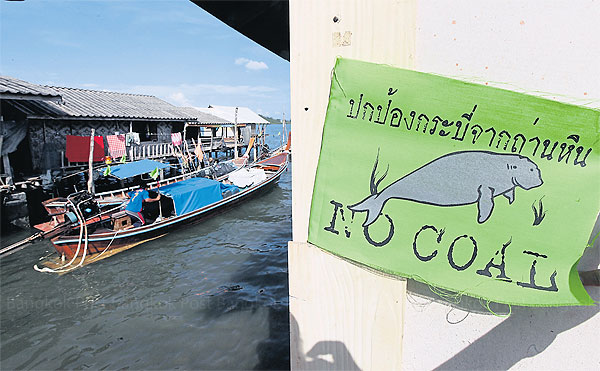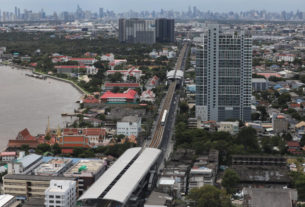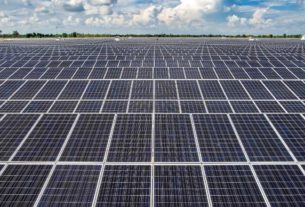Anti-coal banners can be spotted on various places in Krabi’s Nua Khlong district where locals are fighting against the construction of a coal-fired power plant. (Photo by Thiti Wannamontha)
Plans by the Office of Natural Resources and Environmental Policy and Planning (ONREPP) to re-designate parts of coastal community areas in Krabi as an environmental protection zone may sound like a good news for local conservationists. But this is not necessarily so.
The area, encompassing Ao Sak, Nua Khlong, Khlong Thom and Koh Lanta districts, is known for its pristine marine ecology that helps put the spot on the world-class tourist map.
The re-designation is important given the area is also facing the threat of a coal-fired power plant built by the electricity Generating Authority of Thailand (Egat), and a coal jetty that may compromise not only its beauty but also the way of life of the locals, mostly small-scale fishermen.
The controversial power plant, which is to be located in Nua Khlong district, is strongly opposed by locals.
ONREEP chief Kasemsant Jinnawaso is still optimistic that introducing the environmental zone will be good for the coastal area which is blessed with rich marine ecology such as coral reefs, wetland, and sea grass. The re-designation is expected to take effect soon.
He tried to ease the worries of locals, saying: “It does not mean we have allowed Egat to build its power plant there.
“Developers need to follow laws and regulations,” he said.
His office required a provincial committee headed by the governor to conduct a public hearing into the power plant, instead of the developers.
Last year, the Egat conducted three hearings which were criticised by opponents as mere window dressing. It also submitted an environmental impact assessment (EIA) report to ONREPP.
However, Mr Kasemsant urged the power plant opponents to look at the big picture of energy security, citing the five-hour blackout in the southern region in May 2013 that hit the southern economy hard.
A conspiracy theory did the rounds at the time — that the blackout was deliberately engineered to create collective fears over a loss of energy security in order to justify Egat’s coal-fired power plant.
Environmentalists, however, dispute claims about a loss of energy security if the plant project does not go ahead.
“Egat tries to make society think the southern region is blackout-prone and so needs power plants,” said Suphakit Nantavorakarn, from the Healthy Public Policy Foundation.
“But the country is not energy-starved,” said Mr Suphakit, a staunch oppponent of the project.
Last year, the country produced 6,437 megawatts (MW) of electricity. This includes a 23% reserve margin against the standard reserve of 15%. According to the Power Development Plan, Thailand will have enough energy reserves for the next 15 years.
The southern region, in particular, is not short of energy, said Mr Suphakit. Power plants in the region generated 3,888MW of electricity, against 2,468MW last year.
In Krabi, he said, 30% of energy supply comes from renewable sources, mostly from palm oil processing plants, which have the potential to answer to higher demand.
Mr Suphakit said renewable energy, especially from palm waste, and energy-saving campaigns focusing on the switch to light bulbs, are a sustainable solution for the southern region.
”There is more than one way to solve the problem. The government can foster tourism and still look after local agriculture and ecology,” said Mr Suphakit.
”I think society needs to know those power plant projects are promoted because the authorities want to expand petrochemical complexes in the southern area, such as an additional petrochemical zone in Chana district in Songkhla and a deep-sea port with an industrial complex in Satun province,” he said.
Opponents of the plant say they are not surprised by ONREEP’s stance.
”We are dismayed but not surprised. After all, the agency sides with the government and the Energy Ministry,” said Theerapoch Kasirawat, president of the Koh Lanta Tourism Association.
”We have to ask those policy-makers how they choose to develop one industry and ignore the agricultural sector and tourism,” said Mr Theerapoch.
The Krabi and Andaman coastal area, once part of an industrial mining zone, is now a major tourist attraction bringing in billions of baht to state coffers.
Last year, Krabi earned 60 billion baht in revenue, and it was ranked the fifth tourist province after Bangkok, Phuket, Chiang Mai and Chon Buri.
More importantly, it is a vital source of seafood.
“When Thailand suffers an economic crisis, and when investors flee the country to invest elsewhere, we can always count on the tourism sector which provides jobs to locals and brings in revenue. People can still go back to farms and fisheries,” he said.
Locals are worried that the coal pier will be built on ecologically valuable wetlands. Coal-shipping routes will also pass by major tourism diving sites and tourist locations such as Koh Phi Phi, Koh Lanta and Koh Cham.
“The government and Egat need to explain how they will take responsibility if pollution from the power plant and coal-shipping activity damages the environment and tourism here. So far, we are unable to see how they will fix the problem,” said Mr Theerapoch.
Anchalee Kongrut writes about the environment in the Life section, Bangkok Post.
Source: http://www.bangkokpost.com/opinion/opinion/479612/why-a-power-plant-is-bad-news-for-krabi



